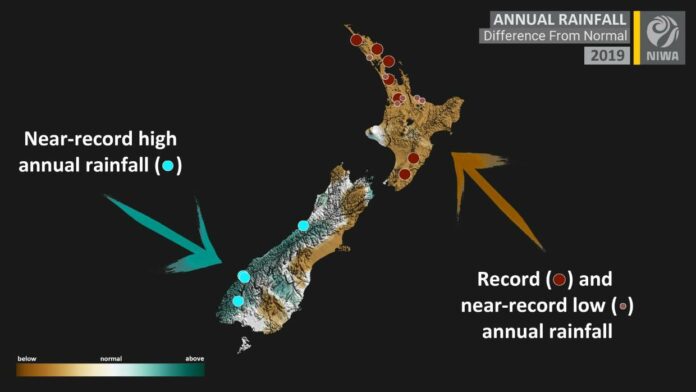Last year was the country’s fourth warmest year since records started in 1909 – and experts say that should be a wake up call.
The National Institute of Water and Atmospheric Research’s (Niwa) annual climate summary released on Thursday said annual temperatures ranged from 0.5 degrees Celsius to 1.2C above average in 2019.
Victoria University of Wellington Professor and climate change scientist James Renwick said the changing temperatures were consistent with climate change predictions.
“This is not centuries away, it’s happening now … it is an urgent problem,” he said.
“This is the number one problem facing all of us, so anything anyone can be doing, they should be doing it.”
Niwa’s report said 80 per cent of the past 20 years were warmer than average. Annual temperatures ranged from 0.5C to 1.2C above average in 2019.
The nationwide average temperature for 2019 was 13.37C, not far behind 2016 – New Zealand’s hottest year on record at 13.45C.
It has now been 35 months since New Zealand has had a month with below-average temperatures.
Renwick said in years to come, the country could expect more fires.
On February 5, tinder dry conditions led to fire in Nelson’s Pigeon Valley – the largest aerial fire fight in New Zealand’s history.
In Tauranga and Hamilton there were 36 consecutive days with no rain, the report said.
Niwa forecaster Nava Fedaeff has called the continuous hot years “worrying” – but they were what Niwa expected in line with climate projections.
Federated Farmers vice president and climate change spokesman Andrew Hoggart said feedback from farmers showed they were adapting to longer summers.
“Productivity in summer is decreasing and productivity in winter is increasing,” he said.
“We’ll get more people looking to have more of their production happening in the winter months.”
Asked if farmers were concerned about the hotter years, Hoggart said: “It’s just another thing you deal with.”
Climate action campaigner and Kāpiti Coast district councillor Sophie Handford said Australia’s bushfires, extreme flooding in many countries, and hotter temperatures at home all pointed to action needed urgently.
“We can’t keep watching hotter years, year on year, and not acting.”
This year’s general election was a chance to vote for the environment, she said.
“The news now that this has been the fourth warmest year on record is really a wake up call,” she said.
“I hope people feel like they have something to be a part of and it’s something in which they can make a difference.”
Climate change was bringing with it more extreme weather, she said.
“We need to be making sure that our communities are responding, and connecting, and ready for the changes that these weather events will bring.”
MetService meteorologist Lisa Murray said the effects of warming were clear – in 2019, MetService issued 65 official severe weather warnings for separate events.
One of the “standout weather events” of 2019 was on the West Coast in March, when a warm sea combined with moisture from the Tropics helped intensify a stalled front, producing an extreme rainfall event, she said. A New Zealand 48-hour rainfall record was set at the Hokitika catchment of the Cropp River when it recorded more than a metre of rain between March 25 and 27 – more than Auckland received over the entire year (920mm).
A state of emergency was declared, roads and bridges were washed away, and major flooding isolated communities, she said.
“Being informed of oncoming severe weather is becoming increasingly important in a changing climate.”
Murray said 2019 was another year with more records broken.
“Many individual stations, like the MetService station in Tauranga, have seen their warmest year.”
Last year continued the trend MetService had noted for years, she said. “We start 2020 with many eastern and northern regions of the country thirsty for some significant rainfall.”
LOOKING AHEAD
From January to March 2020, temperatures are expected to be near or above average in the North Island, and near or below average for the west of the South Island.
The tropics to the north of New Zealand are forecast to become “more active” during the next several weeks, according to Niwa’s seasonal climate outlook.
For the current tropical cyclone season – November 2019 to April 2020 – Niwa indicated the risk for New Zealand was “near normal.”
On average, one ex-tropical cyclone passes near the country each year, bringing heavy rainfall and damaging winds.
– Additional reporting by Harrison Christian
10 HOTTEST YEARS ON RECORD
2016 (+0.84˚C higher than average)
2018, 1998 (tie) (+0.80˚C)
2019 (+0.76˚C)
1999 (+0.74˚C)
2013 (+0.72˚C)
2017 (+0.54˚C)
2005, 1971 (tie) (+0.5˚C)
2010 (+0.46˚C)
Source - stuff





























